Hybrid Magnetorheological Composites for Electric and Magnetic Field Sensors and Transducers
Abstract
:1. Introduction
2. Materials and Methods
- CI microparticles with an average size of m and mass density g/cm. The magnetization curve has been obtained in Ref. [36], where it has been shown that the remanent specific magnetization is 1.24 Am/kg, the coercive field is 1.24 kA/m, and specific saturation magnetization of 210 Am/kg, at a magnetic field intensity higher than 500 kA/m.
- SO with kinematic viscosity 100 cSt and mass density 0.97 g/cm at 298 K.
- Cotton fiber (GB) with a thickness of 0.42 mm. Its structure, visualized with an optical microscope, is shown in Figure 1b.
- A quantity of 3.2 g of SO is mixed with 0.8 g of CI in a Berzelius glass beaker. The mixture is heated until the temperature reaches 423 K. At this temperature, the mixture is homogenized for 300 s, such that the humidity from CI is removed. At the end of this step, one obtains a mixture, denoted S, in which the mass fraction of .
- A quantity of 18 g consisting of CI (40 wt. %), F (18 wt. %) and SO (wt. %) is also prepared in a Berzelius glass beaker placed on a heating source, and it is mixed for 300 s, after its temperature reaches 423 K. As such, the humidity from F is also removed. The obtained sample is denoted by S.
- After the sample S is brought to the room temperature, 9 g are extracted and deposited in a Berzelius glass beaker. Subsequently, to the sample S are added 9 g of SO. The solution is also mixed at 423 K for 300 s, and then is left to reach the room temperature. The obtained liquid solution is denoted by S and it consists of CI, F and SO with mass fractions wt. %, = 9 wt. %, and, respectively, wt. %.
- From the sample S, one extracts 6 g of the liquid mixture, and pours it into a Berzelius glass beaker. A quantity of 1.2 g of CI and 10.8 g of SO is added, and the whole mixture is homogenized at 423 K for 300 s, and then is left to reach the room temperature. The obtained liquid solution is denoted by S and it consists of CI, F and SO with mass fractions wt. %, = 6 wt. %, and, respectively, wt. %.
- From the sample S, one extracts 9 g of the liquid mixture, and pour it into a Berzelius glass beaker. A quantity of 1.8 g of CI and 7.2 g of SO is added, and the whole mixture is homogenized at 423 K for 300 s, and then it is left to reach the room temperature. The obtained liquid solution is denoted by S and it consists of CI, F and SO with mass fractions wt. %, = 3 wt. %, and, respectively, wt. %. Table 1 summarizes the composition of samples obtained in these steps.
- One cuts eight plates of textolites in the form of squares with edge length 30 mm. One side of each plate is covered with copper, as shown at position 1 in Figure 2. Additionally, four pieces of GB are prepared with the same dimensions. Each piece has a mass of g.
- Each hMC is placed between the copper sides of two textolite plates. Thus, one obtains the the electrical device, as shown in Figure 3.
3. Structural and Magnetic Characterization
4. Results and Discussion
4.1. Measurements of Electrical Capacitance and Resistance
4.2. Theoretical Model and Comparison with Experimental Data
5. Conclusions
Author Contributions
Funding
Acknowledgments
Conflicts of Interest
Data Availability
References
- Chung, D.D.L. Composite Materials: Science and Applications, 2rd ed.; Springer: London, UK, 2010. [Google Scholar]
- Awual, M.R.; Hasan, M.M.; Asiri, A.M.; Rahman, M.M. Cleaning the arsenic(V) contaminated water for safe-guarding the public health using novel composite material. Compos. Part B Eng. 2019, 171, 294301. [Google Scholar] [CrossRef]
- Awual, M.R. Novel ligand functionalized composite material for efficient copper(II) capturing from wastewater sample. Compos. Part B Eng. 2019, 172, 387–396. [Google Scholar] [CrossRef]
- Ma, J.; Azhar, U.; Zong, C.; Zhang, Y.; Xu, A.; Zhai, C.; Zhang, L.; Zhang, S. Core-shell structured PVDF@BT nanoparticles for dielectric materials: A novel composite to prove the dependence of dielectric properties on ferroelectric shell. Mater. Des. 2019, 164, 107556. [Google Scholar] [CrossRef]
- Sayed, F.; Kotnana, G.; Muscas, G.; Locardi, F.; Comite, A.; Varvaro, G.; Peddis, D.; Barucca, G.; Mathieu, R.; Sarkar, T. Symbiotic, low-temperature, and scalable synthesis of bi-magnetic complex oxide nanocomposites. Nanoscale Adv. 2020, 2, 851–859. [Google Scholar] [CrossRef] [Green Version]
- Kotnana, G.; Sayed, F.; Joshi, D.; Barucca, G.; Peddis, D.; Mathieu, R.; Sarkar, T. Novel mixed precursor approach to prepare multiferroic nanocomposites with enhanced interfacial coupling. J. Magn. Magn. Mater. 2020, 511, 166792. [Google Scholar] [CrossRef]
- Samal, S.; Škodová, M.; Blanco, I. Effects of Filler Distribution on Magnetorheological Silicon-Based Composites. Materials 2019, 12, 3017. [Google Scholar] [CrossRef] [PubMed] [Green Version]
- Testa, P.; Style, R.W.; Cui, J.; Donnelly, C.; Borisova, E.; Derlet, P.M.; Dufresne, E.R.; Heyderman, L.J. Magnetically Addressable Shape-Memory and Stiffening in a Composite Elastomer. Adv. Mater. 2019, 31, 1900561. [Google Scholar] [CrossRef] [PubMed]
- Li, Z.; Yang, F.; Yin, Y. Smart Materials by Nanoscale Magnetic Assembly. Adv. Func. Mater. 2020, 30, 1903467. [Google Scholar] [CrossRef]
- Bodniewicz, D.; Kaleta, J.; Lewandowski, D. The fabrication and the identification of damping properties of magnetorheological composites for energy dissipation. Compos. Struct. 2018, 189, 177–183. [Google Scholar] [CrossRef]
- Chen, D.; Yu, M.; Zhu, M.; Qi, S.; Fu, J. Carbonyl iron powder surface modification of magnetorheological elastomers for vibration absorbing application. Smart Mater. Struct. 2016, 25, 115005. [Google Scholar] [CrossRef]
- Fu, Y.; Yao, J.; Zhao, H.; Zhao, G.; Wan, Z.; Guo, R. A muscle-like magnetorheological actuator based on bidisperse magnetic particles enhanced flexible alginate-gelatin sponges. Smart Mater. Struct. 2019, 29, 015019. [Google Scholar] [CrossRef]
- Shabdin, M.K.; Abdul Rahman, M.A.; Mazlan, S.A.; Ubaidillah; Hapipi, N.M.; Adiputra, D.; Abdul Aziz, S.A.; Bahiuddin, I.; Choi, S.-B. Material Characterizations of Gr-Based Magnetorheological Elastomer for Possible Sensor Applications: Rheological and Resistivity Properties. Materials 2019, 12, 391. [Google Scholar] [CrossRef] [Green Version]
- Zainudin, A.A.; Yunus, N.A.; Mazlan, S.A.; Shabdin, M.K.; Abdul Aziz, S.A.; Nordin, N.A.; Nazmi, N.; Abdul Rahman, M.A. Rheological and Resistance Properties of Magnetorheological Elastomer with Cobalt for Sensor Application. Appl. Sci. 2020, 10, 1638. [Google Scholar] [CrossRef] [Green Version]
- Wang, S.; Yuan, F.; Liu, S.; Zhou, J.; Xuan, S.; Wang, Y.; Gong, X. A smart triboelectric nanogenerator with tunable rheological and electrical performance for self-powered multi-sensors. J. Mater. Chem. C 2020, 8, 3715–3723. [Google Scholar] [CrossRef]
- Yun, G.; Tang, S.Y.; Sun, S.; Yuan, D.; Zhao, Q.; Deng, L.; Yan, S.; Du, H.; Dickey, M.D.; Li, W. Liquid metal-filled magnetorheological elastomer with positive piezoconductivity. Nat. Commun. 2019, 10, 1300. [Google Scholar] [CrossRef] [Green Version]
- Song, B.K.; Yoon, J.Y.; Hong, S.W.; Choi, S.B. Field-Dependent Stiffness of a Soft Structure Fabricated from Magnetic-Responsive Materials: Magnetorheological Elastomer and Fluid. Materials 2020, 13, 953. [Google Scholar] [CrossRef] [PubMed] [Green Version]
- Coon, A.; Yang, T.H.; Kim, Y.M.; Kang, H.; Koo, J.H. Application of Magneto-Rheological Fluids for Investigating the Effect of Skin Properties on Arterial Tonometry Measurements. Front. Mater. 2019, 6, 45. [Google Scholar] [CrossRef]
- Khazoom, C.; Véronneau, C.; Bigué, J.L.; Grenier, J.; Girard, A.; Plante, J. Design and Control of a Multifunctional Ankle Exoskeleton Powered by Magnetorheological Actuators to Assist Walking, Jumping, and Landing. IEEE Robot. Autom. Lett. 2019, 4, 3083–3090. [Google Scholar] [CrossRef]
- Bastola, A.K.; Hoang, V.T.; Li, L. A novel hybrid magnetorheological elastomer developed by 3D printing. Mater. Des. 2017, 114, 391–397. [Google Scholar] [CrossRef]
- Qi, S.; Guo, H.; Fu, J.; Xie, Y.; Zhu, M.; Yu, M. 3D printed shape-programmable magneto-active soft matter for biomimetic applications. Compos. Sci. Tech. 2020, 188, 107973. [Google Scholar] [CrossRef]
- Bastola, A.; Paudel, M.; Li, L. Dot-patterned hybrid magnetorheological elastomer developed by 3D printing. J. Magn. Magn. Mater. 2020, 494, 165825. [Google Scholar] [CrossRef]
- Chen, Z.; Ren, L.; Li, J.; Yao, L.; Chen, Y.; Liu, B.; Jiang, L. Rapid fabrication of microneedles using magnetorheological drawing lithography. Acta Biomater. 2018, 65, 283–291. [Google Scholar] [CrossRef]
- Harito, C.; Utari, L.; Putra, B.R.; Yuliarto, B.; Purwanto, S.; Zaidi, S.Z.J.; Bavykin, D.V.; Marken, F.; Walsh, F.C. Review—The Development of Wearable Polymer-Based Sensors: Perspectives. J. Electrochem. Soc. 2020, 167, 037566. [Google Scholar] [CrossRef]
- Cheng, H.; Wang, M.; Liu, C.; Wereley, N.M. Improving sedimentation stability of magnetorheological fluids using an organic molecular particle coating. Smart Mater. Struct. 2018, 27, 075030. [Google Scholar] [CrossRef]
- Gurgen, S.; Yildiz, T. Stab resistance of smart polymer coated textiles reinforced with particle additives. Compos. Struct. 2020, 235, 111812. [Google Scholar] [CrossRef]
- Bica, I.; Anitas, E. Magnetic flux density effect on electrical properties and visco-elastic state of magnetoactive tissues. Compos. Part B Eng. 2019, 159, 13–19. [Google Scholar] [CrossRef]
- Simayee, M.; Montazer, M. A protective polyester fabric with magnetic properties using mixture of carbonyl iron and nano carbon black along with aluminium sputtering. J. Ind. Text. 2018, 47, 674–685. [Google Scholar] [CrossRef]
- Grosu, M.C.; Lupu, I.G.; Cramariuc, O.; Hristian, L. Magnetic cotton yarns–optimization of magnetic properties. J. Text. Inst. 2016, 107, 757–765. [Google Scholar] [CrossRef]
- Grosu, M.C.; Lupu, I.G.; Cramariuc, O.; Hogas, H.I. Fabrication and characterization of magnetic cotton yarns for textile applications. J. Text. Inst. 2018, 109, 1348–1359. [Google Scholar] [CrossRef]
- Zhou, Y.; Zhu, W.; Zhang, L.; Gong, J.; Zhao, D.; Liu, M.; Lin, L.; Meng, Q.; Thompson, R.; Sun, Y. Magnetic properties of smart textile fabrics through a coating method with NdFeB flake-like microparticles. J. Eng. Fibers Fabr. 2019, 14, 1–8. [Google Scholar] [CrossRef] [Green Version]
- Bica, I.; Anitas, E. Magnetic field intensity effect on electrical conductivity of magnetorheological biosuspensions based on honey, turmeric and carbonyl iron. J. Ind. Eng. Chem. 2018, 64, 276–283. [Google Scholar] [CrossRef]
- Bica, I.; Anitas, E.M.; Choi, H.J.; Sfirloaga, P. Microwave-assisted synthesis and characterization of iron oxide microfibers. J. Mater. Chem. C 2020, 8, 6159–6167. [Google Scholar] [CrossRef]
- Bica, I.; Anitas, E.M.; Lu, Q.; Choi, H.J. Effect of magnetic field intensity and γ-Fe2O3 nanoparticle additive on electrical conductivity and viscosity of magnetorheological carbonyl iron suspension-based membranes. Smart Mater. Struct. 2018, 27, 095021. [Google Scholar] [CrossRef]
- Bica, I.; Anitas, E. Magnetic field intensity and γ-Fe2O3 oncentration effects on the dielectric properties of magnetodielectric tissues. Mater. Sci. Eng. B 2018, 236–237, 125–131. [Google Scholar] [CrossRef]
- Marinică, O.; Susan-Resiga, D.; Bălănean, F.; Vizman, D.; Socoliuc, V.; Vékás, L. Nano-micro composite magnetic fluids: Magnetic and magnetorheological evaluation for rotating seal and vibration damper applications. J. Magn. Magn. Mater. 2016, 406, 134–143. [Google Scholar] [CrossRef]
- Ercuta, A. Sensitive AC Hysteresigraph of Extended Driving Field Capability. IEEE Trans. Instrum. Meas. 2020, 69, 1643–1651. [Google Scholar] [CrossRef]
- Melle, S. Study of the Dynamics in Magnetorheological Suspensions Subject to External Fields by Means of Optical Techniques. Ph.D. Thesis, University of Madrid, Madrid, Spain, 1995. [Google Scholar]
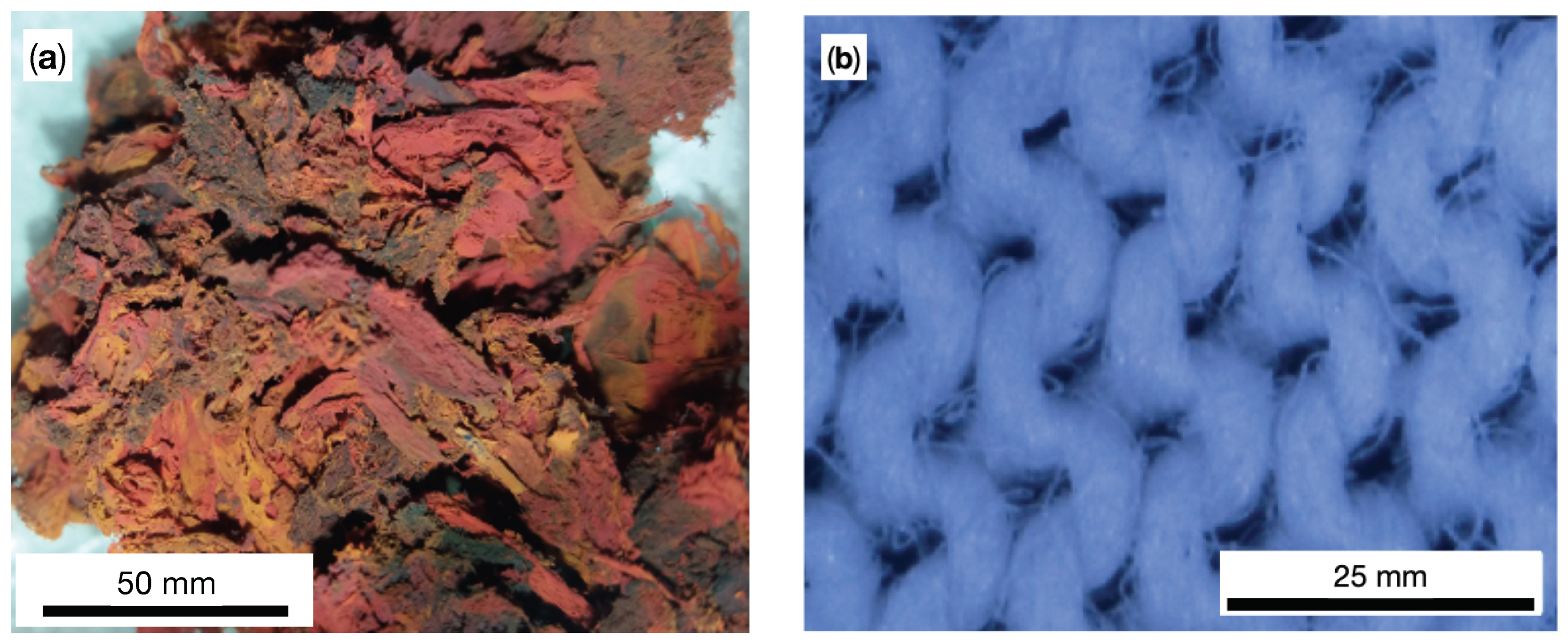
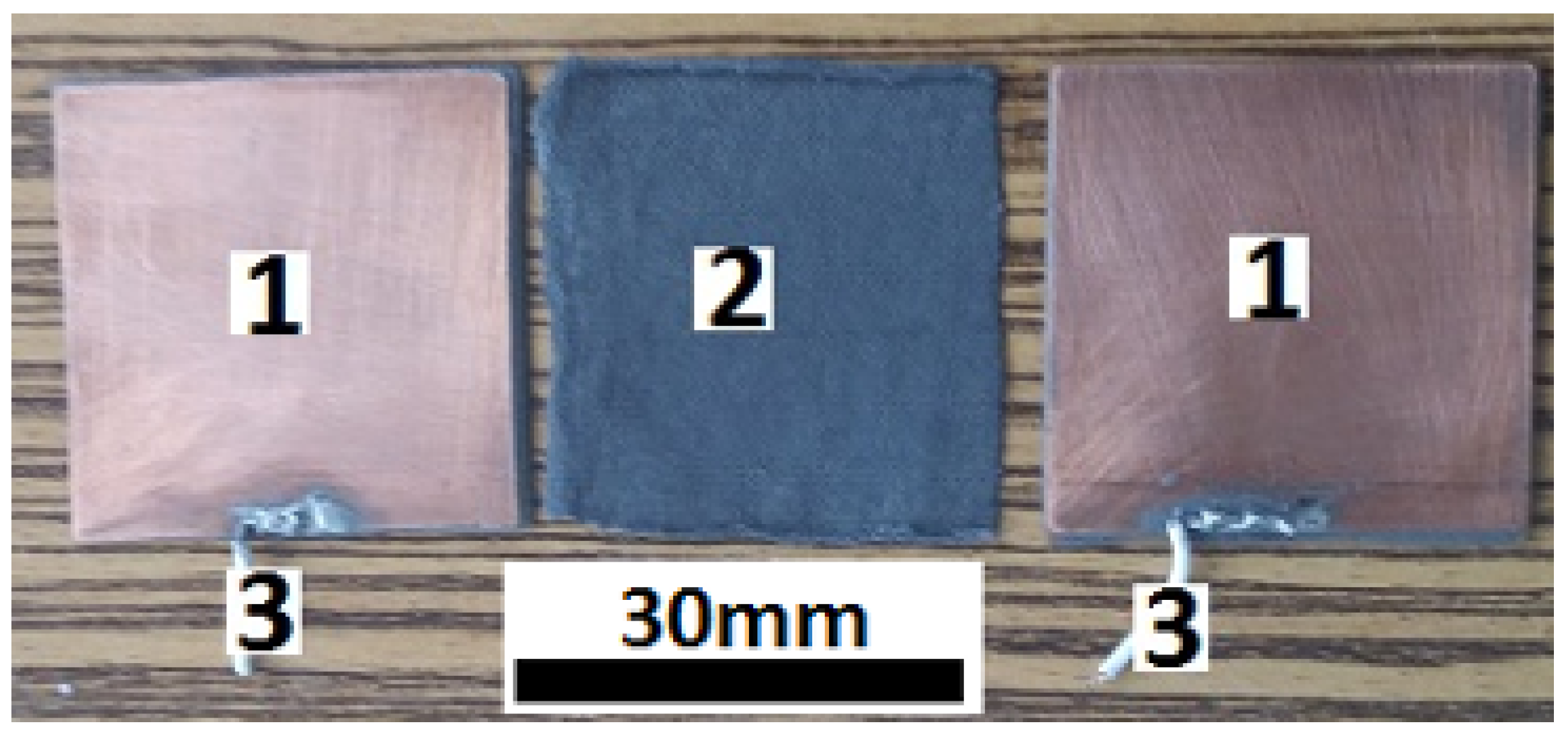
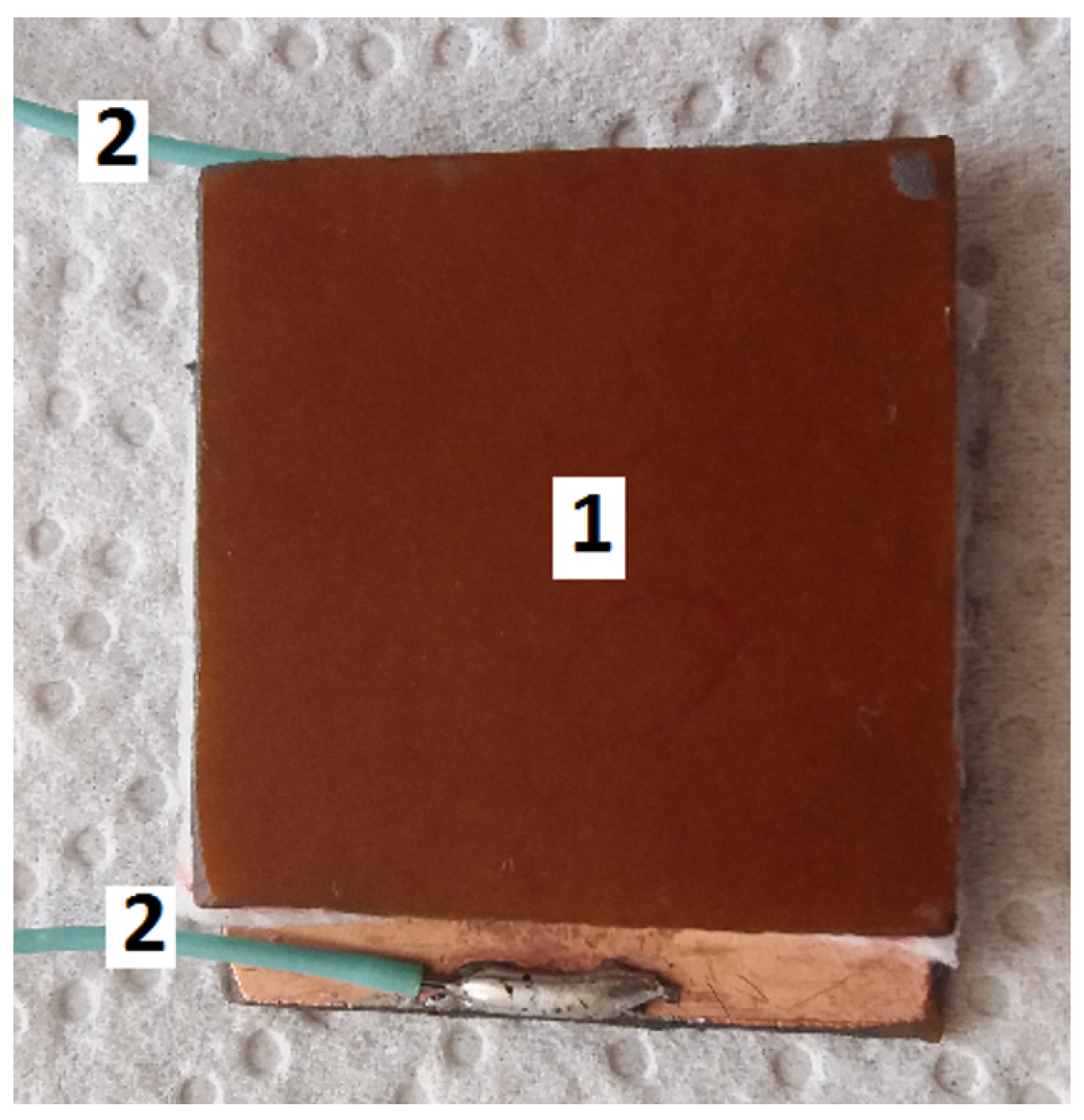



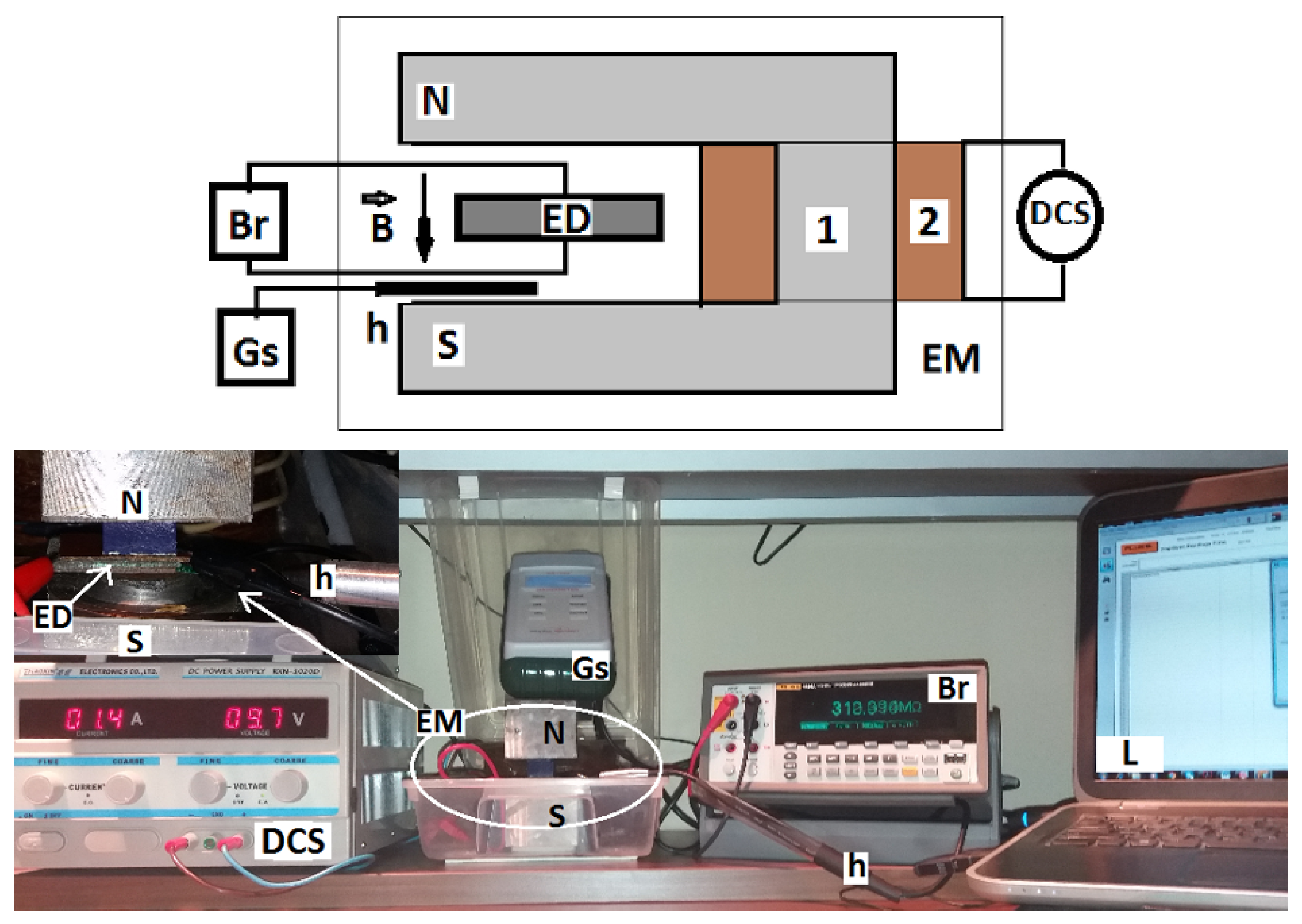


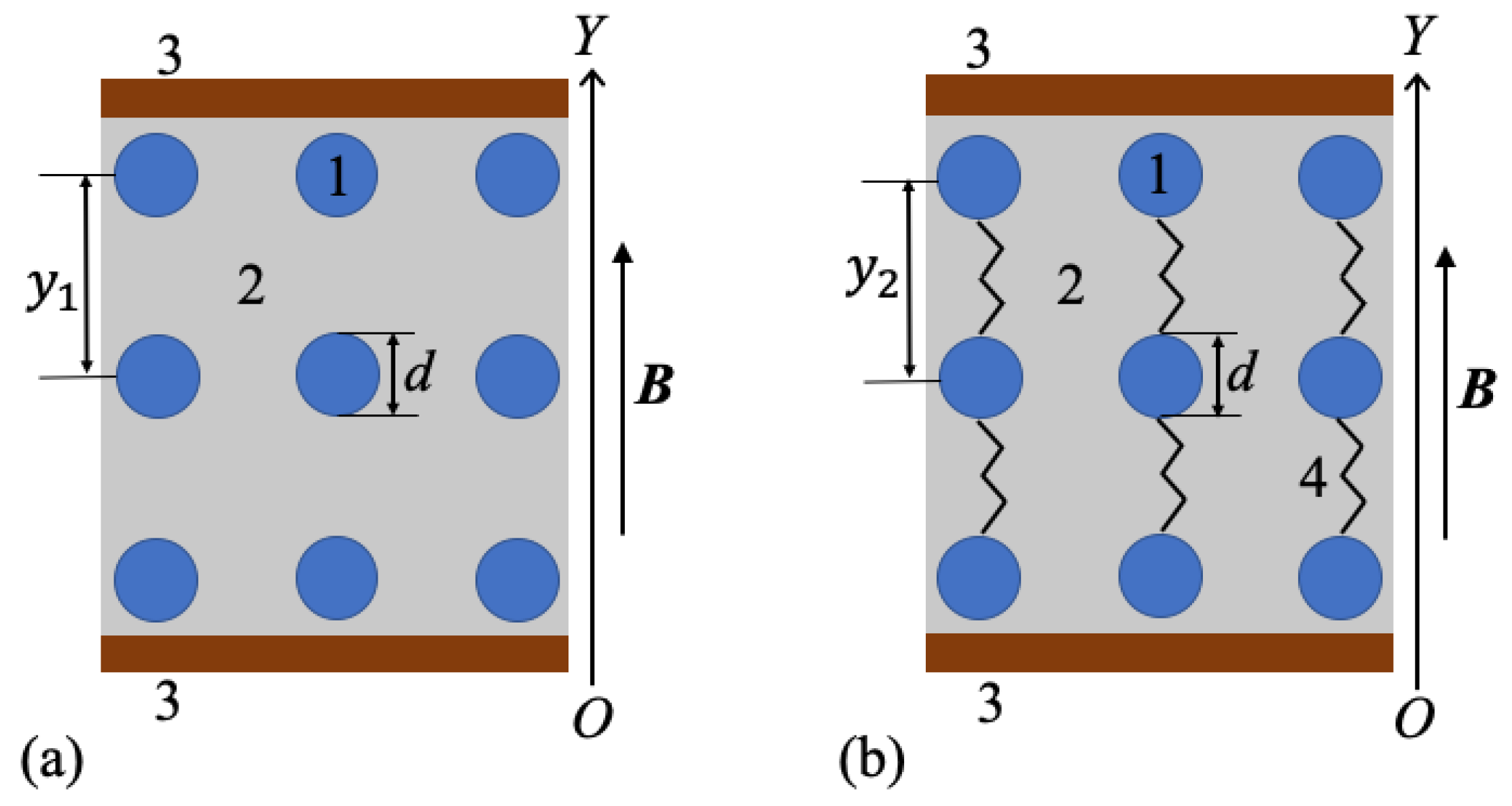
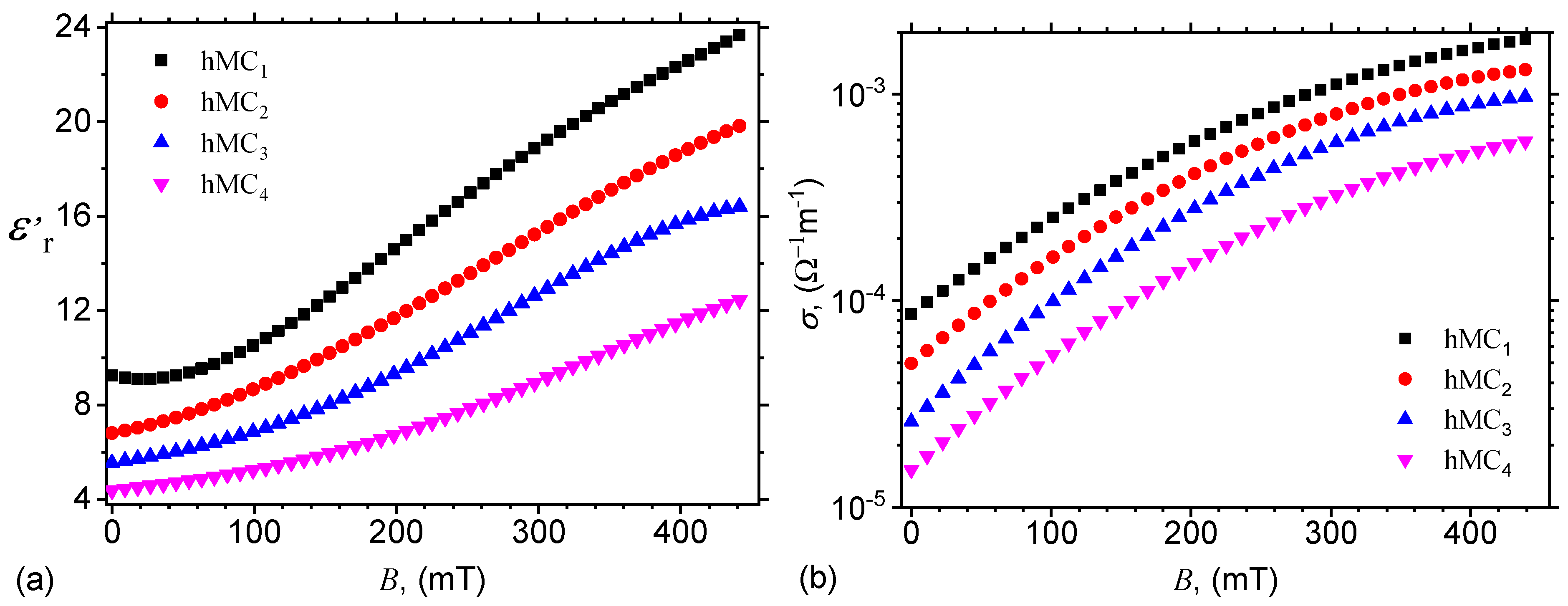
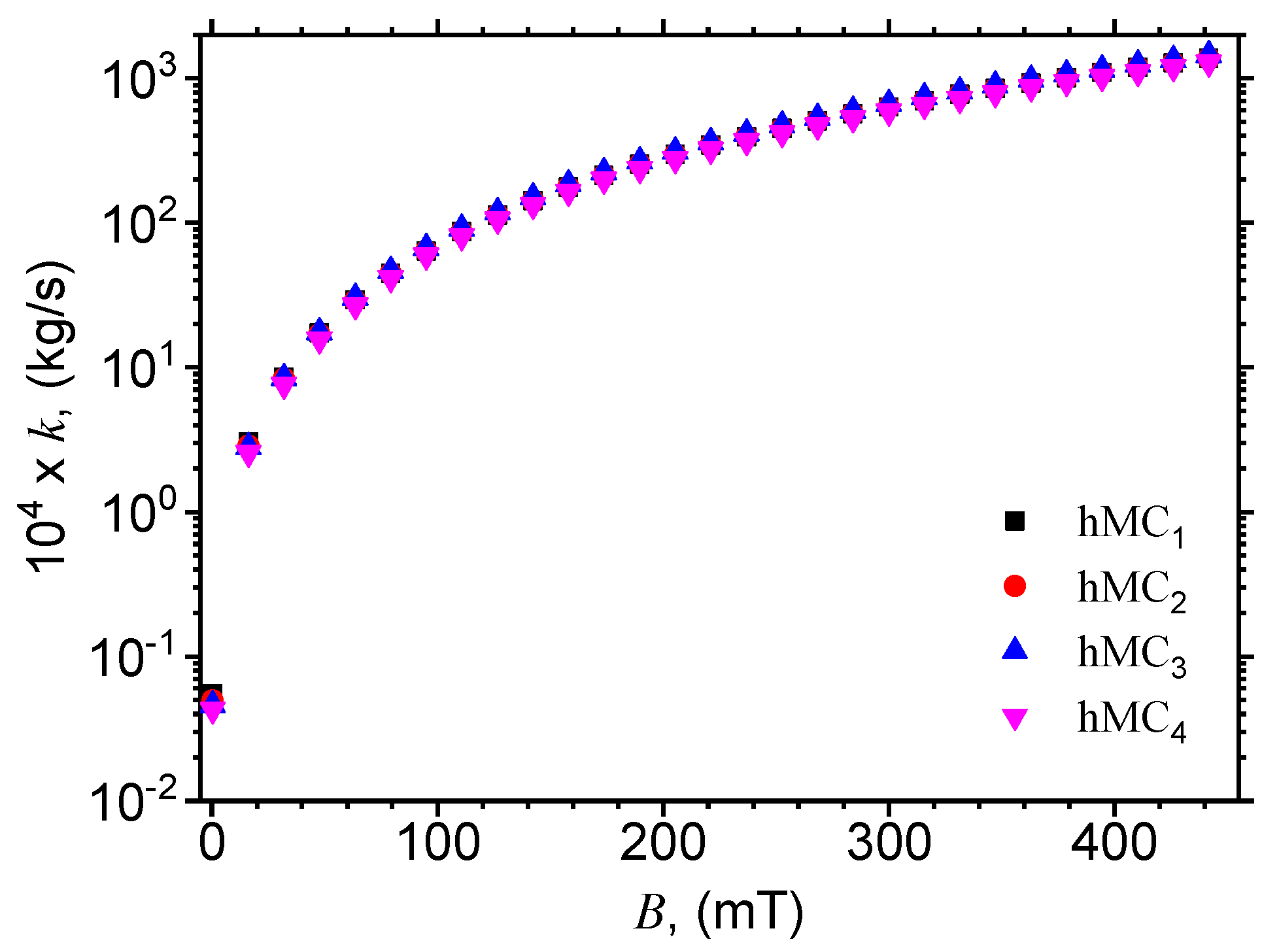
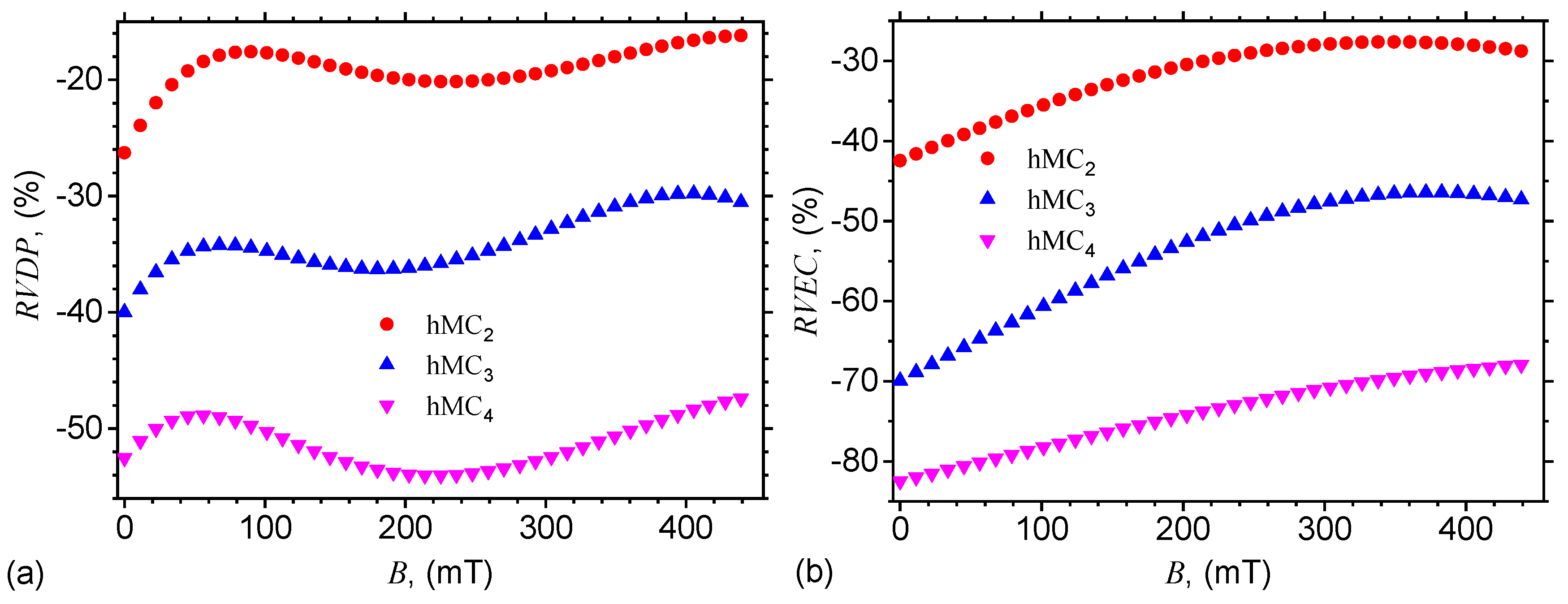
| Sample | (wt. %) | (wt. %) | (wt. %) |
|---|---|---|---|
| 20 | 80 | 0 | |
| 20 | 77 | 3 | |
| 20 | 74 | 6 | |
| 20 | 71 | 9 |
| Sample | (wt. %) | (wt. %) | (wt. %) | (wt. %) |
|---|---|---|---|---|
| 17.24 | 16.55 | 66.21 | 0.00 | |
| 17.24 | 16.55 | 63.73 | 2.48 | |
| 17.24 | 16.55 | 61.25 | 4.96 | |
| 17.24 | 16.55 | 58.77 | 7.44 |
Publisher’s Note: MDPI stays neutral with regard to jurisdictional claims in published maps and institutional affiliations. |
© 2020 by the authors. Licensee MDPI, Basel, Switzerland. This article is an open access article distributed under the terms and conditions of the Creative Commons Attribution (CC BY) license (http://creativecommons.org/licenses/by/4.0/).
Share and Cite
Bica, I.; Anitas, E.M.; Chirigiu, L. Hybrid Magnetorheological Composites for Electric and Magnetic Field Sensors and Transducers. Nanomaterials 2020, 10, 2060. https://doi.org/10.3390/nano10102060
Bica I, Anitas EM, Chirigiu L. Hybrid Magnetorheological Composites for Electric and Magnetic Field Sensors and Transducers. Nanomaterials. 2020; 10(10):2060. https://doi.org/10.3390/nano10102060
Chicago/Turabian StyleBica, Ioan, Eugen Mircea Anitas, and Liviu Chirigiu. 2020. "Hybrid Magnetorheological Composites for Electric and Magnetic Field Sensors and Transducers" Nanomaterials 10, no. 10: 2060. https://doi.org/10.3390/nano10102060
APA StyleBica, I., Anitas, E. M., & Chirigiu, L. (2020). Hybrid Magnetorheological Composites for Electric and Magnetic Field Sensors and Transducers. Nanomaterials, 10(10), 2060. https://doi.org/10.3390/nano10102060






